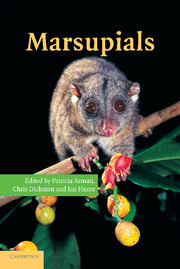Book contents
- Frontmatter
- Contents
- List of Contributors
- Preface
- 1 The evolution and classification of marsupials
- 2 What marsupials can do for genetics and what genetics can do for marsupials
- 3 Reproduction
- 4 Lactation
- 5 Nutrition and digestion
- 6 The nervous system
- 7 The immunolymphatic system
- 8 Ecology and life histories
- 9 Behaviour
- 10 Conservation and management
- References
- Index
- Plate Section
5 - Nutrition and digestion
Published online by Cambridge University Press: 07 August 2009
- Frontmatter
- Contents
- List of Contributors
- Preface
- 1 The evolution and classification of marsupials
- 2 What marsupials can do for genetics and what genetics can do for marsupials
- 3 Reproduction
- 4 Lactation
- 5 Nutrition and digestion
- 6 The nervous system
- 7 The immunolymphatic system
- 8 Ecology and life histories
- 9 Behaviour
- 10 Conservation and management
- References
- Index
- Plate Section
Summary
Classification of foods and nutritional niches
The foods used by marsupials include both vertebrate and invertebrate animal matter, the vegetative (roots, bark, stems, petioles, leaves) and reproductive tissues (buds, flowers, seeds, fruit, nectar, pollen) of plants as well as exudates (sap, gums) and epigeal (above-ground) and hypogeal (below-ground) fungi. The major components of plant and animal matter and the main nutrients (and anti-nutrients) they contain are shown in Fig. 5.1. Anti-nutrients are either toxic to the animal ingesting them (e.g. alkaloids, phenolics) or interfere with digestion of nutrients in the animal (e.g. lignin, tannins).
The water and nitrogen contents of a wide range of foods, both plant and animal, are shown in Fig. 5.2. Generally, animal material is high in water, protein, vitamins and minerals, and sometimes fat, but low in carbohydrate. In contrast, plants consist mostly of carbohydrates, and are often low in protein and fat. Saps and some seeds are particularly low in protein. Carbohydrates are found in both the cell contents and the cell walls of plants. The sugars and non-structural storage polysaccharides (mainly starch) in the cell contents are easily digested, but the carbohydrates in plant cell walls are structural polysaccharides (mainly cellulose and hemicelluloses) that are difficult to digest, and are often protected from mastication and microbial attack by lignin, a family of phenolic polymers. Together, the structural carbohydrates and lignin make up the cell-wall constituents or plant fibre.
- Type
- Chapter
- Information
- Marsupials , pp. 137 - 158Publisher: Cambridge University PressPrint publication year: 2006
- 8
- Cited by

